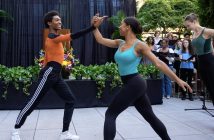
Jane Dawson, Ph.D.
Photo by Joseph McLaughlin
As the Protestant Reformation swept across Europe, those who rebelled against Catholicism cast their new forms of worship in opposition to the Catholic Mass—including its music.
How sacred music developed as part of the Reformation was explored in a presentation on Sept. 22 by Jane Dawson, Ph.D., the John Laing Professor of Reformation History at Edinburgh University’s School of Divinity.
By the late Middle Ages, Dawson said, the performance of sacred music was relegated mainly to professionals who could understand its polyphonic structure. Protestants, however, feared the power of music to influence and distract, so they stipulated that church music must serve the words—because the words were the word of God.
“They also stipulated that words should be audible and that the language must be comprehensible,” Dawson said. “The final maxim was that singing should ‘profit’ the church.” That meant church music was to be performed by the entire congregation.
This “triumph of the word,” as the Protestant Reformation has been traditionally regarded, marked a decisive shift from a visual and sensual culture to a logocentric and literary one. It was Protestantism that replaced polyphony with the voicings that are still used today—soprano, alto, tenor and bass.
In Scotland, which underwent its Reformation beginning in 1560, a metrical Psalter containing Old Testament psalms that had been transposed from their polyphonic versions helped grow a popular culture.
“More than 1 million copies of the Protestant psalm book were available in 1640 in England and Scotland,” Dawson said.
For the first time, Scots were singing together in church. This practice was vital in enabling the non-literate majority of Scots to cope with a religion of the word.
“In this non-literate society, you are able to create a popular culture through singing which, essentially, is learning by listening,” she said.
The psalms were also used as protest songs in the battle between Catholicism and Protestantism. For example, Scottish Protestants sang from the psalms—“Judge and revenge my cause, Oh Lord, from them that evil be”—at the downfall of the Catholic Mary Queen of Scots in 1567.
Singing in church led to the singing of religious songs in the house, which then gave rise to songs sung in private prayers, Dawson said.
“Singing helped Protestants to cope with what Peter Marshall has called the ‘displacement of Purgatory,’” she said. “It was a way to deal with the guilt and awareness of sin.”
Her presentation, “Singing the Reformation,” was held on the Lincoln Center campus and was part of the St. Robert Southwell, S.J., Lecture Series.


